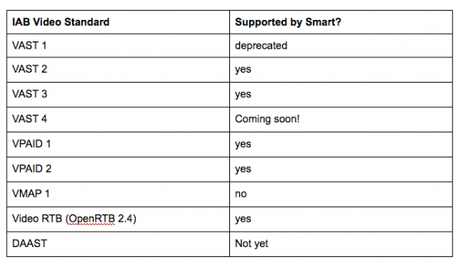The first piece in our series on video advertising standards, The Evolution of IAB Video Standards, traces the history of VAST, VPAID and VMAP. The second article explores VAST 4.0.’s response to market challenges through the creation of advertiser and publisher controls. This third and last article in the series focuses specifically on the standard’s response to new screens and connected devices.

It’s clear that the industry trend is moving towards OTT (over-the-top) TV; eMarketer projected back in 2015 that this yein 2016 there will be 186.9 million OTT video service users who bypass traditional distribution to watch streaming video over the internet via YouTube, Netflix, Amazon or Hulu.

According to the latest Diffusion Report, “The Future of OTT TV Advertising, 2014 – 2020”, the result will be a decrease in traditional TV advertising revenue (from $59.9 billion to $47.5 billion in 2018) and an increase in OTT TV revenue ($8.4 billion to $31.5 billion). In addition, according to Emarketer, more than half of the U.S. population will be watching streaming content on connected TVs this year, and the amount of U.S. connected TV viewers will rise to 200 million by 2019.
Some new screens already support digital video advertising, but one of the major drawbacks has been the low quality resolution of the video creatives which are dedicated for use online. Everyone (from advertisers to publishers to viewers) agrees that it’s not fit for display on high resolution TVs.
VAST 4.0 directly addresses this issue; it includes support for the “mezzanine file” — a large, high quality file used for ad-stitching services and other ad vendors. It’s used to create files for high-resolution screens, making it perfect for big-screen TVs hooked up to connected TV services. It’s key to note that the format isn’t ready to be displayed by the platform “as is”. Once a platform or player receives it for the first time, the service will download the file, put it in the appropriate format and then host it. Once this preparation is done, the file is ready to be displayed each time the campaign is called upon.
The process of stockage and rediffusion is made possible thanks to the Universal Ad ID, the creative ad identifier that is standardized across systems. Many regions have a regulating authority that takes charge of distributing the IDs — in the U.S it’s the Professional Regulation Authority of Advertising (ad-id.org) and in France it’s ARPP (arpp-pub.org).
The inclusion of such a technical element aimed directly at advertising in the OTT environment is proof that VAST 4.0 is preparing for the industry’s inevitable turn towards new screens and new devices. But the IAB has gone even further in its efforts to standardize by publishing “Digital Video Ad Format Guidelines and Best Practices”, which focuses on the definition of quality level standards for video files.
Why the focus on quality levels? Well, the mezzanine file isn’t the only media file necessary for the process of serving and playing video ads; VAST version 4.0 still includes ready-to-use video files for delivery to desktop and mobile. Until now, ad servers, publishers and advertisers each defined their own encoding profile for these files, but the lack in standardization lead to low-quality diffusion and no guarantee that a linear video advertisement would play correctly. The IAB recognized the issues this posed for the industry and took the opportunity to outline three quality levels, guaranteeing the smooth play of linear video advertisements on all devices.
Dynamic Insertions
Dynamic insertions are a novel way for publishers to deliver advertisements on different screens. These insertions of advertisements directly into the video stream are the newest way to send video content and advertisements in a single stream. There are a few different advantages: reduced buffering of streaming videos, the diffusion of video via various channels or websites, and a reduction of ad blocking possibilities. There are also some limitations associated with that type of ad insertion, such as the lowest interactivity and tracking capabilities, so in the end ad-stitching should not be seen as the best solution for every use case, but it’s another debate.
Previous versions of VAST defined the delivery of ads from the client side only (that is, the video player). However, in case of dynamic insertions, VAST 4.0 clarifies the roles of the technologies involved and turns this responsibility over to the stitching server, which communicates with the ad server and is in charge of not only inserting the advertisement (after processing of the “mezzanine file”), but also managing VAST tracking elements like measurement. In short, the standard defines the responsibility of the stitching server rather than the video player, as it did before for client-side ad delivery, allowing dynamic insertions to benefit video advertisements viewed across all screens, including top-box televisions.
What does the future hold?
VAST 4 brings a strong industry standard that has taken into account advertiser controls, publisher controls and multi-screen dedicated technical elements. The standards are key and obviously necessary for ensuring advertisements play across all platforms and screens. Moreover, the new standards are not only in line with the trends and reflective of the ways publishers and advertisers seek to monetize, but they also positively impact user experience. But how can the industry as a whole take advantage of all the IAB has standardized in VAST 4 if many video players and ad vendors are still using VAST 2?
The answer is simple: skip VAST 3 and go straight to VAST 4. Standards are rolled out fast, and it’s often hard for everyone involved to keep up, but if you’ve found you’re behind the curve, adopt the most recent standard rather than muddling through the layers.

Sources
http://www.iab.com/guidelines/digital-video-ad-serving-template-vast-4-0/
http://www.iab.com/wp-content/uploads/2016/01/VAST_4-0_2016-01-21.pdf
http://www.iab.com/guidelines/digital-video-player-ad-interface-definition-vpaid-2-0/
https://www.youtube.com/watch?v=4tNj3YbI45c
https://www.jwplayer.com/blog/vast-vpaid-standardizing-online-video-ads/
http://adage.com/article/digital/brands-check-publishers-ad-viewability-math/298746/
http://digiday.com/platforms/future-digital-tv-advertising-5-charts/
http://blogs.wsj.com/cmo/2015/07/14/why-is-dynamic-ad-insertion-for-tv-taking-so-long/
http://digiday.com/publishers/wtf-server-side-ad-insertion/
http://www.emarketer.com/Article/Netflix-Usage-Reach-More-than-Two-Thirds-of-OTT-Users/1013833?ecid=NL1002
